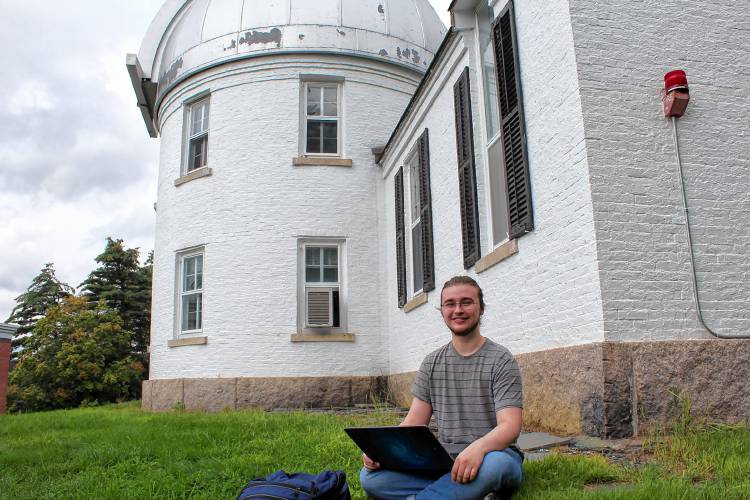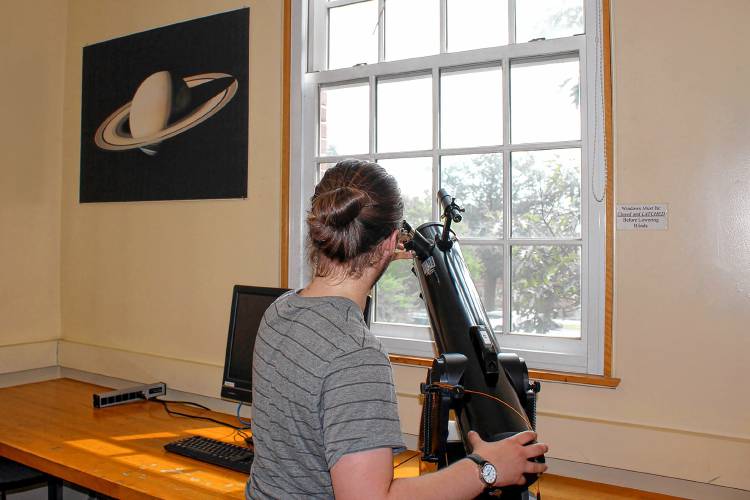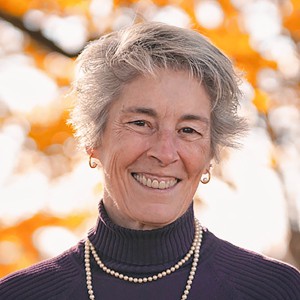Hartford High grad discovers 2 new planets for senior thesis
| Published: 09-03-2023 5:11 AM |
Jack Duranceau knew from a young age growing up in Quechee that he wanted to do something with science, though the specifics of the job changed “week by week,” he said.
The scope finally narrowed in the summer of 2016 when, in his first year of high school, he attended an astronomy summer camp run by the Governor’s Institutes of Vermont. “Astronomy” as a blanket field had piqued his interest, but this experience opened his eyes to the nitty-gritty.
“I really enjoyed the data processing and just the work in general,” he said. “So I said, ‘OK, I’m going to continue with this as far as I’m still interested.’ And I’m still very interested. So it’s worked out.”
Before graduating from Hartford High School in 2019, Duranceau built a telescope as part of his honors capstone, saying he “just kind of dipped my toes in” and “sort of taught” himself how to take in and use astronomical data.
But that was peanuts compared to his latest venture: the discovery of two exoplanets — planets far outside Earth’s solar system — 257 light-years away.
The planetary finding is the key element of Duranceau’s roughly 130-page senior thesis at Dartmouth College, not far from where he grew up.
“I think we often have a few undergraduate students a year who are working on research that leads directly to a published paper,” said Elisabeth Newton, who’s been an assistant professor of physics and astronomy at Dartmouth since 2019. “But I haven’t had an undergrad-led paper yet, so this is definitely a first for me.”
Duranceau said the thesis took a year and a half of intense work and was published when he graduated in June with a bachelor’s degree in physics and astronomy. Duranceau said exoplanets are the “sweet spot” of astronomy — far enough out that you can’t see them from a backyard, but easier to grasp than things like galaxies or the formation of the universe itself.
Article continues after...
Yesterday's Most Read Articles
 Dartmouth moves swiftly to stymie demonstration, leads to 90 arrests
Dartmouth moves swiftly to stymie demonstration, leads to 90 arrests
 Dartmouth graduate student-workers go on strike
Dartmouth graduate student-workers go on strike
 At Dartmouth, hundreds protest ongoing war in Gaza and express support for academic freedom
At Dartmouth, hundreds protest ongoing war in Gaza and express support for academic freedom
 Art Notes: City Center Ballet celebrates 25 years
Art Notes: City Center Ballet celebrates 25 years
“For me, it’s easier to connect with because astronomy is such a far-out concept or field of study,” he said. “It’s just a really interesting thing. I live on a planet, so what do other planets look like?”
The two planets, TOI 3353b and TOI 3353c, are nearly three times the size of Earth and share traits with ice giant Neptune. Duranceau found them using data from the Transitory Exoplanet Survey Satellite, or TESS, which was launched by NASA and MIT in the spring of 2018.
TESS tracks about 200,000 stars across space for drops in brightness caused by planetary transits, which is when a planet orbits between the view of the star and the telescope.
Duranceau’s planets are two of 230 exoplanet discoveries so far this year, bringing the total number to 5,496, according to NASA data. Though astronomers have been interested in these discoveries since the early 1990s, there were fewer than 1,000 confirmed through 2013.
But with improved transiting technology, the number had ballooned to nearly 3,500 in 2016, when NASA’s Kepler K2 mission greatly increased monitoring. Since TESS was launched in 2018, NASA has logged an average of 332 discoveries per year.
The first component of Duranceau’s thesis was confirming that the planets are, in fact, planets. TESS flags only potentials, and astronomers’ expertise and modeling are then required to confirm that the decreases in light are from planet overlap, not any other phenomena such as star spots.
Duranceau created a computer model using what he called a long, fancy algorithm to simulate what parameters would be needed to have a planet in the area. He ran that more than 30,000 times, which took multiple weeks, tweaking throughout to ensure the hypothetical conditions were still in line with reality. Those were then successfully compared to the original TESS data, and two more planets were officially born.
“It’s very cool. And honestly, I was just excited that I got the model to work, like getting my code to run. Because going in, I knew there were probably two planets here,” he said. “So it wasn’t really a (single) moment of confirmation. It was just like each time improving the likelihood, improving the confidence, that there are two planets here until we can actually say they do exist.”
Once the numbers proved Duranceau correct, he had to date the system by looking at how much lithium the star had — something he had extensive experience with during his sophomore and junior years working for Dr. Newton’s lab group. He found that the host star, TOI 3353, is 22.8 million years old, relatively senior in an aging crowd of exoplanet solar systems.
“Young stars are really important to study because a lot of the dynamic activity that happens in those systems — like atmospheric loss, like planets losing their atmospheres or moving in and out, planetary migration, closer in or farther away from the star — all that happens within the first few hundred million years,” he said. “So if we look only at older stars, we miss out on a lot of that action. … The whole goal is to learn more about how planets evolve over time.”
Despite their ice giant characteristics, his model also showed that both planets orbit star TOI 3353 from only 4.6 million miles and 7.4 million miles away. That is compared to 2.8 billion miles for Neptune, its closest relative in Earth’s solar system. The two are also between the size of Earth and Neptune, “a very common outcome of the planet formation process,” said Newton, but something there are no examples of in Earth’s solar system.
Duranceau aims to expand and solidify his research over the next year while continuing to study under Newton. He plans to publish a peer-reviewed paper based on his findings and then attend graduate school to get a Ph.D.
“It’s been really great having him in the group for the past couple of years, and we’re glad he’s still sticking around for a little while,” Newton said.
Despite what some might consider a grueling, long and taxing scientific process, it is clear that the grind doesn’t bother Duranceau. With a love for statistical analysis and “making my fun plots,” he could be a star in the making himself.



 Colby-Sawyer names interim president
Colby-Sawyer names interim president
